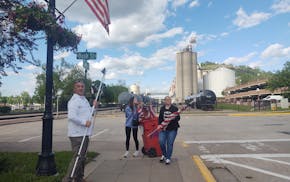WINDOM, Minn. — His brown eyes stare directly at the viewer, not as a challenge, but as their equal.
At a time when immigration stings are breaking apart families, sweeping innocent and guilty alike into their net, the young boy's gaze conveys a humanity that will not be denied.
"I'm NOT illegal," he has written on the wooden back of his school desk. The crayons he used lie before him.
The boy was painted by Vicki Beckendorf, an artist, violinist and newspaper editor who lives in Martin County near the Iowa border. For decades she has thought about people marginalized by mainstream society, as well as the ways we harm the natural world. Both themes have made their way into her exhibit at the Cottonwood County Historical Society in Windom, where it will be on display until fall.
Who knows why some of us have empathy that runs a mile deep while others of us foment division. Beckendorf deeply cares about her neighbors, her friends, and people she's never met and never will. Surrounded by corn and soybean fields and hog farms, she has devoted her small acreage to rescuing cats, potbelly pigs, and dogs.
She wasn't born in Martin County. She wasn't even born in a rural area. She was born in Brooklyn, New York, nearly 65 years ago, and was raised in Detroit before attending school in Chicago. Detroit, when she was a kid, was a wreck, with Lake Erie polluted by industrial contamination and racial divides exacerbated by riots.
But the city kid had a Martin County grandmother and aunts and uncles. Every year her family vacationed there, and on her grandmother's land she found an oasis of peace and beauty. When she was 25, she left Chicago and moved permanently to Martin County, where she eventually married and created her own oasis.
She devotes two nights a week to painting in her studio at her 1912 farmhouse. Often, they're portraits of people enduring hardship, whose stories she has come across online or in print.
There's a woman who lost her entire family in a South American mudslide. A family of Bosnian refugees. A pair of nannies whose privileged white charges created a documentary about them. A man who had been born into slavery and whose photo was taken in the 1960s.
Beckendorf's views have been shaped by social protest literature, including the works of Charles Dickens, and by the Lutheran and Methodist churches she attended. She calls herself a follower of Jesus — not a Christian, as she feels the term has been co-opted by people who don't actually follow Jesus — and those views also play a role.
She believes all humans are created in God's image, and that God loves them even if they've committed crimes.
"I believe it's imperative to for us to remember that and to treat people as our brothers and sisters, period," she said.
Beckendorf generally doesn't know the people she paints, just the stories that accompany their photos.
She once worked with a Guatemalan immigrant who spoke hardly any English and regularly sent money home to his family. He and his wife were working in the U.S. long enough so they could earn enough money to buy used printing equipment for his son's print shop in Guatemala. During that time, Guatemalan gangs badly injured his son, and he had to make an emergency trip home. She never knew what happened to the son, but she assumed he had recovered enough for his parents to return to the U.S.
She doesn't have solutions for America's immigration challenges. But she does think people need to stop talking about immigration and start talking to immigrants.
"We are good people, we are smart people. We can have these conversations," she says. "I think we can come up with solutions."
Talking to them will mean getting to know them, and maybe people will stop seeing immigrants, even those who have arrived without permission, as other.
"If you can somehow empathize with the reasons they're fleeing and the amount of courage it takes to leave your home country, because I think about that: What would it take for me to leave this country?" she said. "I admire their bravery."
Living in rural Minnesota means that some of her views are at odds with her friends'. In hog country, she gets ribbed for being a vegetarian. But people also support her; even those who hold completely different views come to her exhibitions and concerts. She's thankful for the arts and music education she received in the city, but loves living where she does.
"My head is urban, but my heart is rural," she says.
The Windom exhibit is the second showing of this group of paintings, which first hung in Fairmont. Visitors get the chance to leave comments and pick their favorite painting.
In this conservative area, where at least one local sheriff has signed an agreement to cooperate with ICE, guests' favorite was the painting of the young boy.

Tolkkinen: Farm dogs are so cute, except for all their disgusting habits

Tolkkinen: From Hmong radio to cannabis, southern Minnesota is adapting to the times

Tolkkinen: I paid to attend a Constitution conference. But it was an ad for Christian nationalism.


